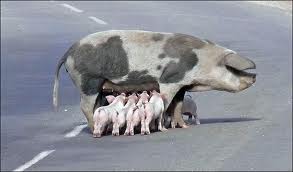 October and November are especially dangerous months for drivers to potentially collide with deer because the animals are mating. According to figures compiled by State Farm, auto accidents involving deer reached 2.3 million over the past two years. However, a rising national population of feral hogs is creating a new and even more dangerous hazard for drivers.
October and November are especially dangerous months for drivers to potentially collide with deer because the animals are mating. According to figures compiled by State Farm, auto accidents involving deer reached 2.3 million over the past two years. However, a rising national population of feral hogs is creating a new and even more dangerous hazard for drivers.
Dr. Billy Higginbotham, a wildlife specialist with the Texas AgriLife Extension Service and a professor at Texas A&M University said, “The bucks throw caution to the wind as they chase does during the breeding season. If this happens to carry them across a roadway, they don’t seem to care.” The typical scenario in an auto crash involving a deer is for the driver to react to a doe darting across the road by braking, only to strike the pursuing buck upon acceleration.
Deer are not, however, the only, or necessarily the most dangerous wildlife road hazard drivers face. Increasingly, drivers are being forced to contend with the presence of feral hogs. In 1982, the animals were present in approximately 17 states. By 2004, they had spread to 28 states and are now present in at least 37 states including Alaska.
In Texas, feral hogs are present in 95 percent of the state’s counties. Because the hogs are intelligent omnivores with one of the highest reproductive rates on the planet, their numbers are likely to continue to grow. Unlike deer, which tend to go over a vehicle in a collision, said Higginbotham, hogs go under, causing much more costly damage. Auto accidents involving feral hogs are also more likely to be life-threatening due to the greater chance of a rollover.
One advantage drivers have in watching for and avoiding deer is that the animals’ eyes are reflective and flash in the headlights. Drivers in states where deer exist in dense numbers instinctively watch the sides of the road and know not to alter their speed or change the strength of the headlamp beams. Both will startle deer grazing along the road and cause them to bolt.
Hog eyes, on the other hand, do not reflect light, making them virtually invisible at night. Additionally, hogs are dark in coloration and are short in stature, hugging the ground and further decreasing their visibility. Their bodies are dense, with large males weighing 300 lbs. or more.





